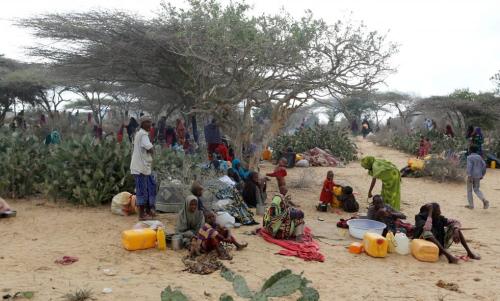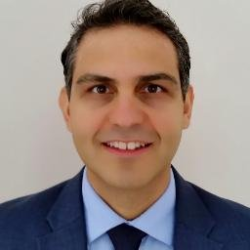In January, the Global Economy and Development program at the Brookings Institution and World Vision convened two dozen experts to explore how to approach state fragility. Fragile states, or countries with weak governance capacities, are the most susceptible to large-scale crises that cause massive human suffering, spread the infection of instability and drain national wealth. Here we discuss the key issues raised at that meeting that need further exploration.
The Stakes
Roadblock to the SDGs?
The development community—both those in political and economic development and those who work on humanitarian relief—has yet to fully confront the fragility roadblock to reducing global poverty. While most countries are on a path to reduce poverty through economic growth, the lack of progress in a group of unstable, fragile countries will prevent the world from achieving the 2030 “leave no one behind” objectives set forth in the United Nations Sustainable Development Goals (SDGs). Estimates put 80 percent of global extreme poverty in fragile states by around 2030. To remove this roadblock, we must attach to the SDGs a new urgency to solve collective problems of understanding, action, and financing both within fragile countries and in developed countries.
Framing Fragility
What is the scope of fragility?
Fragile states do not respond well to the appellation. The World Bank and Fund for Peace list of 50 fragile states includes countries that are unstable today and others that might become unstable. Per the Organization for Economic Cooperation and Development fragility framework, they are fragile for many different reasons where topline risks outweigh domestic capacities to manage them. Views on fragility extend over the political environment, conflict and terrorism, poverty and economic growth, and rules stability.
The new OECD report States of Fragility 2016 presents a typology of fragility—political, societal, economic, environmental, security—that encompasses a “whole-of-society” breadth of fragility from conflict and disasters to destitution and high rates of hunger, illiteracy, and maternal and infant mortality. The report has made clear that tackling fragility, therefore, requires a “whole of government” approach—both within developed countries and in fragile countries to rally political will, conduct joint assessments, pool resources, and partner with multiple stakeholders.
Whole of Government
Engaging state and society?
State building efforts have often gone wrong by defining “whole-of-government” as top-down and highly centralized. State building must improve government capacity so that the state can legitimately respond to societal needs. The report U.S. Leadership and the Challenge of State Fragility by the Fragility Study Group rightly identifies fragility as “the failure to forge a minimally inclusive, legitimate, and accountable compact between the state and society.” A dual focus on state building and the social contract must connect the priorities and practices of diplomacy, defense, and development to arrive at durable solutions to conflict, unchecked natural disasters, and extreme poverty. Yet, because fragility is large and complex, there needs to be a broad theory of change to simplify and guide collective efforts to strengthen the state and social contract, deliver public goods, and manage risks that might disrupt progress and spiral out of control.
Fragility and Resilience
What is “from fragility to resilience?”
Although some have found the prevailing resilience discourse too thin on political fragility, the development community’s recent “fragility-to-resilience” frame pays close attention to the critical role of the social contract between government and society, political economy analysis, and the need to compensate for weak formal institutions and low social cohesion. More joint efforts are needed to further advance a distinctive fragility-to-resilience approach and take it from theory to practice.
The starting point is fragility, which begins with analysis of root causes like broken social contracts, low social cohesion, and weak governing institutions. Risks and vulnerabilities focus on how those root causes may affect the economic, social, political, security, and physical infrastructure of a society. Resilience envelopes the whole process and identifies the adaptive solutions and end goal.
The important thing is for the analysis to be across disciplines (and across government silos) so solutions are built on the interconnectedness of the various risks, fragilities, and adaptive capacities. The U.N. secretary-general’s report for the World Humanitarian Summit ambitiously advances a resilience agenda in its call for local governments, civil society, and the private sector to join forces with international partners from the peace and security, development, environment, and relief communities to collectively map risks, create a problem statement, and develop a plan to leverage existing capacities. While skepticism may exist on this level of effort, the aid community has experimented with similar approaches for over a decade, often reinventing the wheel without the benefit of a global doctrine or consolidated lessons and good practice on multi-stakeholder coordination.
Institutions and Social Capital
How to use local institutions when they are so weak? How to build relations between the state and civil society? How to create social capital and cohesion among groups?
Most in the development community agree on the importance of local ownership and the role of local institutions. But there is not a recognized path forward when local institutions are weak. The 2016 OECD peer review of U.S. assistance criticizes the U.S. for dealing mainly with non-state actors and not engaging (even without direct funding) in state building and systems strengthening, especially weak systems. On the flipside, many multilateral banks and fragile countries prefer a focus on repairing the formal sector, when there would be considerable gains made by giving attention to the informal sector.
The right approach is to work with both formal and informal institutions, looking for ways to strengthen and connect the best opportunities. The evolving concept of social capital provides a guide for resilience in fragile countries, calling for efforts to strengthen collective support within communities (bonding), across them (bridging), and between communities and government (linking). Although larger cross-disciplinary processes may be needed to solve collective action and resource problems, per the U.N. secretary-general’s report, those processes must enable the tasks of strengthening social capital and promoting social contracts in fragile countries. These efforts are what drive the shift from fragility to resilience. They are difficult, iterative, and decades long.
What are the case studies of success and failure in working with fragile states?
There is need for a collective stocktaking of the myriad of individual projects. We need to know what success looks like, which requires a theory of change for moving from fragility to resilience. Small, unambitious projects can have high ratings, but will they get to the root causes and deliver at scale?
In addition, the goal posts must be widened to include more of the development community’s experience in fragile states, instead of only that of humanitarian, peace, and security communities. The Millennium Challenge Corporation (MCC) and U.S. Agency for International Development have a wealth of experience in reducing poverty and improving governance in fragile states, as does the World Bank and other donors. We need to guide more adaptive programs for reducing conflict, mitigating disaster, and ending poverty, rather than only managing conflict and transitioning out of emergency.
The role of the private Sector
What interest does the private sector have in reducing instability, in building resilience?
There is a shared interest between government and the private sector in the stability of countries, avoiding conflict and pandemics, and reducing global “bads” such as terrorism and trafficking. Companies are finding a market at the bottom of the pyramid, and foreign investment is on the rise in fragile states. Of the 1600 USAID public-private partnership since 2001, one-third are in the 50 countries on the list of fragile states. Northern and southern hemisphere companies have an interest in, and can contribute to, stability of fragile countries. Northern multinational companies in resource extraction, consumer goods, and technology enter fragile markets to find the resources and grow their consumer markets. Southern companies may be more adept, have more relevant experience, and better understand the market potential in fragile states.
What is the role of government in subsidizing and supporting private sector engagement in fragile states?
Since private sector activity is critical to economic growth and stability, donors should reduce the risk for private investment by providing incentives such as political risk insurance, guaranteeing finance, and equity and angel capital. The World Bank’s Facility for Conflict-Affected and Fragile Economies, part of the Multilateral Investment Guarantee Agency, has been a step in the right direction.
Conditionality or Reward
Conditionality or reward success and progress?
On balance, the history of conditioning aid is not good. The MCC has pioneered an alternative approach of rewarding progress. But even its compacts contain an element of conditionality and can be suspended or terminated for failure to fulfill conditions. The New Deal for Fragile States has tried a “bargain” approach, but neither the donors nor the G7+ countries have yet to live up to the bargain. Is there a “resilience” approach that avoids the one-sided nature of conditionality and offers both parties some assurance that the other will live up to the accord? Could this be based on shared risks assessments, more blended capacities to link formal and informal sectors, and whole-of-government and whole-of-society approaches focused on the social contract and social capital?
U.S. Interests in a Multi-Polar World
How to convince policymakers of the importance of fragility and resilience?
Selling points for donor engagement in fragile states are heavily pitched as means to contain security threats. But there is also a case for the long-term potential of frontier and emerging markets, which the private sector is acknowledging through its investment. Beyond this is the case that in the coming multi-polar world, emerging powers will continue to build alliances with fragile states for their resources and markets, to win them over to their worldview, to gain votes in the U.N., and to push back against established power structures.
China is playing a dominant role of political influence and investment in fragile states, with other powers such as India, Russia, Brazil, Turkey, South Africa, and the regional development banks all increasing their engagement. Fragile states should be viewed as an opportunity for the U.S. to form new alliances and networks and leverage existing ones; otherwise, emerging multi-polar networks will pose a challenge to what a retired Admiral recently referred to as the “global operational system” that has been shaped by the U.S. security, economic, cultural, and worldview order. Unilateral military, economic, and political interventions by the U.S. in fragile states will become exponentially more difficult where the operating system no longer supports these activities.







Commentary
Rethinking how to reduce state fragility
March 29, 2017